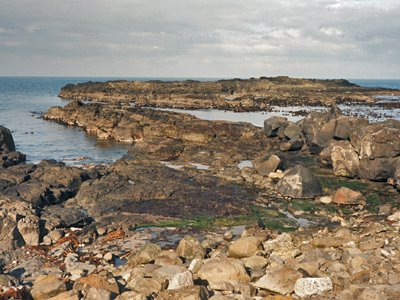Earth Science Conservation Review
| Dunseverick Slip | Antrim |

| Site Type: | Coastal section |
| Site Status: | ASSI |
| Council area: | Moyle District Council |
| Grid Reference: | C99994455 |
| Google maps: | 55.23783,-6.42957 |
| Rocks | |
|---|---|
| Rock Age: | Tertiary (Eocene, Palaeocene) |
| Rock Name: | Antrim Lava Group, Interbasaltic Formation, Tholeiitic Middle Basalt Member |
| Rock Type: | Andesite, Tholeiite |
| Interest | |
| Other interest: | flow unit, spherulitic, Extrusion, A fishing boat slipway is adjacent to site. Some d |
Summary of site:
A lava flow of a unique rock type derived from the Causeway Tholeiite Member of the Antrim Lava Group provides the main interest of this site.
Molten rocks generally evolve as they cool. During crystal formation the growing minerals take elements selectively from the melt, leaving it depleted in some and relatively enriched in others, so that the last fraction to solidify can be very different in composition from the original. This process is called differentiation. In the case of basalt lavas, like those of the Causeway Tholeiite Member, they erupt and cool so rapidly that there is hardly time for differentiation to occur but in this rare case it has. The resulting rock is a type called a tholeiitic andesite, containing relatively more quartz than the original tholeiite. Another unusual feature of the rock is the presence of ellipsoid and sub-spherical associations of crystals up to 30cm across, consisting of radiating bunches of long, narrow crystals of plagioclase feldspar. This radiating texture is described as spherulitic. The conditions in which this rock formed involved a superheated melt with relatively few particles for crystals to form around. This would have delayed crystal formation and slow cooling would have further limited the number of crystal nucleii. The melt would then have been supercooled and in these conditions when crystallisation did commence it would have rapidly created the radiating skeletal and bunched crystals seen here.
The exposure at Dunseverick boat slip originally showed a lava flow of tholeiitic andesite 2m thick enclosed within the normal tholeiitic basalt sequence. It has a planar base but the top of the flow was still liquid when the next lava covered it. This liquid on liquid event is also uncommon. The material collected and mentioned in the full record as being in Queen's University Geology department may now be in the Ulster Museum collections. The liquid on liquid contact is no longer visible, having been obscured by the construction of a new slipway. It could be restored without significantly affecting the operation of the slip.
Molten rocks generally evolve as they cool. During crystal formation the growing minerals take elements selectively from the melt, leaving it depleted in some and relatively enriched in others, so that the last fraction to solidify can be very different in composition from the original. This process is called differentiation. In the case of basalt lavas, like those of the Causeway Tholeiite Member, they erupt and cool so rapidly that there is hardly time for differentiation to occur but in this rare case it has. The resulting rock is a type called a tholeiitic andesite, containing relatively more quartz than the original tholeiite. Another unusual feature of the rock is the presence of ellipsoid and sub-spherical associations of crystals up to 30cm across, consisting of radiating bunches of long, narrow crystals of plagioclase feldspar. This radiating texture is described as spherulitic. The conditions in which this rock formed involved a superheated melt with relatively few particles for crystals to form around. This would have delayed crystal formation and slow cooling would have further limited the number of crystal nucleii. The melt would then have been supercooled and in these conditions when crystallisation did commence it would have rapidly created the radiating skeletal and bunched crystals seen here.
The exposure at Dunseverick boat slip originally showed a lava flow of tholeiitic andesite 2m thick enclosed within the normal tholeiitic basalt sequence. It has a planar base but the top of the flow was still liquid when the next lava covered it. This liquid on liquid event is also uncommon. The material collected and mentioned in the full record as being in Queen's University Geology department may now be in the Ulster Museum collections. The liquid on liquid contact is no longer visible, having been obscured by the construction of a new slipway. It could be restored without significantly affecting the operation of the slip.
| Enlander, I., Dempster, M. & Doughty, P., 2025. Dunseverick Slip, County Antrim, site summary. [In] Earth Science Conservation Review. https://www.habitas.org.uk/escr/summary.php?item=73. Accessed on 2025-04-03 |
| Previous Site | Next Site |

